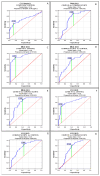Serum Clusterin Concentration and Its Glycosylation Changes as Potential New Diagnostic Markers of SARS-CoV-2 Infection and Recovery Process
- PMID: 38673784
- PMCID: PMC11049940
- DOI: 10.3390/ijms25084198
Serum Clusterin Concentration and Its Glycosylation Changes as Potential New Diagnostic Markers of SARS-CoV-2 Infection and Recovery Process
Abstract
COVID-19 is an infectious disease caused by the SARS-CoV-2 virus. Glycoprotein clusterin (CLU) has many functions such as phagocyte recruitment, complement system inhibition, apoptosis inhibition, hormone and lipid transport, as well as in the immune response. The study aimed to assess the changes in CLU concentrations and the profile and degree of CLU glycosylation between patients with severe COVID-19, convalescents, and healthy subjects (control). The profile and degree of serum CLU N-glycosylation were analyzed using lectin-ELISA with specific lectins. CLU concentrations were significantly lower and relative reactivities of CLU glycans with SNA (Sambucus nigra agglutinin) were significantly higher in severe COVID-19 patients in comparison to convalescents and the control group. The relative reactivities of CLU glycans with MAA (Maackia amurensis agglutinin), together with relative reactivity with LCA (Lens culinaris agglutinin), were also significantly higher in patients with severe COVID-19 than in convalescents and the control group, but they also significantly differed between convalescents and control. The development of acute inflammation in the course of severe COVID-19 is associated with a decrease in CLU concentration, accompanied by an increase in the expression of α2,3-linked sialic acid, and core fucose. Both of these parameters can be included as useful glycomarkers differentiating patients with severe COVID-19 from convalescents and the control group, as well as convalescents and healthy subjects.
Keywords: COVID-19; lectin-ELISA; serum clusterin glycosylation.
Conflict of interest statement
The authors declare no conflicts of interest.
Figures


Similar articles
-
Glycosylation Pattern of Serum Clusterin in Psoriatic Arthritis and Rheumatoid Arthritis-The Search for New Diagnostic Glycomarkers.Int J Mol Sci. 2024 Dec 5;25(23):13060. doi: 10.3390/ijms252313060. Int J Mol Sci. 2024. PMID: 39684771 Free PMC article.
-
The Association between Clusterin Sialylation Degree and Levels of Oxidative-Antioxidant Balance Markers in Seminal Plasmas and Blood Sera of Male Partners with Abnormal Sperm Parameters.Int J Mol Sci. 2022 Sep 13;23(18):10598. doi: 10.3390/ijms231810598. Int J Mol Sci. 2022. PMID: 36142505 Free PMC article.
-
Are Changes in Serum IgG Glycosylation Related to the Severe Course of SARS-CoV-2 Infection and Recovery Process? In Search of New Diagnostic and Prognostic Biomarkers.J Inflamm Res. 2024 Mar 2;17:1413-1427. doi: 10.2147/JIR.S439005. eCollection 2024. J Inflamm Res. 2024. PMID: 38450051 Free PMC article.
-
Could the glycosylation analysis of seminal plasma clusterin become a novel male infertility biomarker?Mol Reprod Dev. 2020 May;87(5):515-524. doi: 10.1002/mrd.23340. Epub 2020 Mar 28. Mol Reprod Dev. 2020. PMID: 32222009 Review.
-
Clusterin: structure, function and roles in disease.Int J Med Sci. 2025 Jan 21;22(4):887-896. doi: 10.7150/ijms.107159. eCollection 2025. Int J Med Sci. 2025. PMID: 39991767 Free PMC article. Review.
Cited by
-
Maackia amurensis seed lectin structure and sequence comparison with other M. amurensis lectins.J Biol Chem. 2025 May;301(5):108466. doi: 10.1016/j.jbc.2025.108466. Epub 2025 Mar 28. J Biol Chem. 2025. PMID: 40158854 Free PMC article.
-
Top-Down Proteomic Profiling of Protein Corona by High-Throughput Capillary Isoelectric Focusing-Mass Spectrometry.J Am Soc Mass Spectrom. 2025 Apr 2;36(4):778-786. doi: 10.1021/jasms.4c00463. Epub 2025 Mar 2. J Am Soc Mass Spectrom. 2025. PMID: 40025702 Free PMC article.
-
Glycosylation Pattern of Serum Clusterin in Psoriatic Arthritis and Rheumatoid Arthritis-The Search for New Diagnostic Glycomarkers.Int J Mol Sci. 2024 Dec 5;25(23):13060. doi: 10.3390/ijms252313060. Int J Mol Sci. 2024. PMID: 39684771 Free PMC article.
References
-
- World Health Organization WHO Director-General’s Opening Remarks at the Media Briefing on COVID-19. 11 March 2020. [(accessed on 14 September 2023)]; Available online: https://www.who.int/director-general/speeches/detail/who-director-genera....
MeSH terms
Substances
Grants and funding
LinkOut - more resources
Full Text Sources
Medical
Research Materials
Miscellaneous

